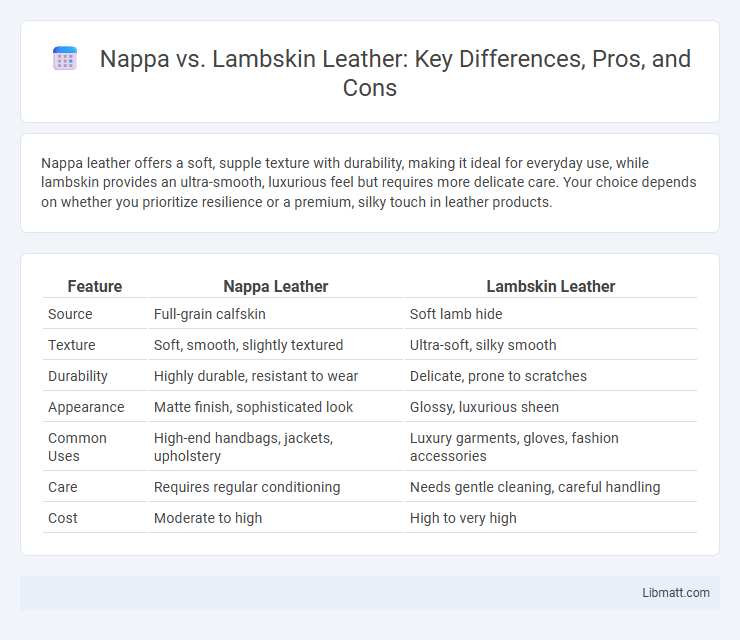Nappa leather offers a soft, supple texture with durability, making it ideal for everyday use, while lambskin provides an ultra-smooth, luxurious feel but requires more delicate care. Your choice depends on whether you prioritize resilience or a premium, silky touch in leather products.
Table of Comparison
| Feature | Nappa Leather | Lambskin Leather |
|---|---|---|
| Source | Full-grain calfskin | Soft lamb hide |
| Texture | Soft, smooth, slightly textured | Ultra-soft, silky smooth |
| Durability | Highly durable, resistant to wear | Delicate, prone to scratches |
| Appearance | Matte finish, sophisticated look | Glossy, luxurious sheen |
| Common Uses | High-end handbags, jackets, upholstery | Luxury garments, gloves, fashion accessories |
| Care | Requires regular conditioning | Needs gentle cleaning, careful handling |
| Cost | Moderate to high | High to very high |
Introduction to Nappa and Lambskin Leathers
Nappa leather is a soft, smooth leather made from full-grain or top-grain animal hides, renowned for its buttery texture and durability. Lambskin leather, derived from young sheep, offers an exceptionally supple and lightweight feel, prized for its fine grain and luxurious softness. Both leathers are popular in high-end fashion and upholstery, with Nappa providing robust wear resistance and Lambskin excelling in delicate elegance.
Origins and Production Processes
Nappa leather, originally developed in Napa Valley, California, is crafted from full-grain unsplit leather treated with a special tanning process to enhance softness and durability. Lambskin leather, derived from the pelts of young lambs, undergoes a delicate tanning method that retains its natural fine grain and silky texture. Both leathers require precise production techniques, with Nappa emphasizing strength and wear resistance, while lambskin focuses on luxurious softness and smoothness.
Texture and Appearance Differences
Nappa leather features a soft, smooth texture with a natural grain that provides a subtle sheen and a supple feel, making it ideal for a luxurious yet durable finish. Lambskin leather offers an ultra-soft, delicate surface with a fine, velvety texture that exudes elegance but requires gentle care to maintain its pristine appearance. Choosing between Nappa and lambskin depends on your preference for durability and tactile experience, with Nappa offering robustness and lambskin emphasizing softness and refined aesthetics.
Durability and Longevity
Nappa leather offers superior durability due to its full-grain quality and natural oils, making it resistant to cracking and wear over time. Lambskin, while exceptionally soft and smooth, is more delicate and prone to scratches and stretching, which can reduce its longevity. Choosing Nappa leather ensures a longer-lasting material ideal for high-use items, whereas lambskin requires careful maintenance to preserve its appearance.
Comfort and Softness Comparison
Nappa leather offers exceptional softness and a supple texture that molds comfortably to your skin, making it ideal for luxury clothing and accessories. Lambskin is known for its ultra-soft, fine grain that feels smooth and delicate, providing a plush comfort often preferred in high-end fashion. Both materials excel in comfort, with Nappa delivering durability alongside softness, while lambskin prioritizes a velvety, gentle touch against your body.
Maintenance and Care Requirements
Nappa leather requires minimal maintenance due to its smooth, durable surface that resists stains and scratches, making it ideal for everyday use. Lambskin demands more delicate care, as its soft, porous texture is prone to scuffs and requires regular conditioning and gentle cleaning to maintain its luxurious appearance. Both types benefit from avoiding prolonged exposure to sunlight and moisture to preserve their quality over time.
Common Uses in Fashion and Accessories
Nappa leather is frequently used in high-end jackets, gloves, and handbags due to its soft texture and durability, offering a luxurious yet resilient finish. Lambskin leather, prized for its incredibly smooth and supple feel, is commonly found in designer clothing, luxury handbags, and premium footwear, providing an elegant and delicate touch. Choosing between Nappa and lambskin each impacts the longevity and aesthetic of Your fashion items, with Nappa suited for more rugged use and lambskin ideal for refined, delicate pieces.
Price and Value Considerations
Lambskin leather typically commands a higher price due to its softness, fine grain, and luxurious feel, making it a preferred choice for premium fashion items and high-end upholstery. Nappa leather, while still premium, offers excellent durability and a smoother surface at a relatively lower cost, providing strong value for consumers seeking both quality and affordability. Understanding the price-to-value ratio helps buyers decide between the plush comfort of lambskin and the robust practicality of Nappa leather based on their budget and usage needs.
Environmental Impact and Sustainability
Nappa leather, often made from more sustainably sourced hides, generally has a lower environmental impact than lambskin, which is softer but derived from young lambs, raising ethical concerns. The tanning processes for Nappa leather increasingly incorporate eco-friendly methods, reducing chemical runoff and water usage compared to traditional lambskin treatments. Consumers seeking sustainability prefer Nappa leather due to its durability and the potential for responsible sourcing practices, minimizing deforestation and methane emissions linked to lamb production.
Choosing Between Nappa and Lambskin
Choosing between Nappa and Lambskin leather depends on your preference for texture and durability. Nappa leather is known for its smooth, supple feel and high durability, making it ideal for everyday use and items that require long-lasting wear. Lambskin offers a softer, luxurious texture with a delicate finish, perfect for accessories where softness and elegance are prioritized over heavy-duty use.
Nappa vs lambskin Infographic

 libmatt.com
libmatt.com